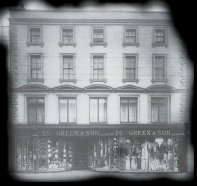The New Inn stood on the High Street for several hundred years to the NE of St
Stephens Church and was the greatest of all Exeter Inns according to Hoskins. The site belonged to the Dean
and Chapter. Around 1445 the Dean & Chapter built 'The New Mansion' with shops and stalls that crowded onto
High Street and into Catherine St and Stephen Street.
 The New Inn was amongst all this lot and became the City's principal Inn, first mentioned in this capacity by 1456 and referrred to as "Le Newe Inne". The Cloth Fair (established in 1454) moved premises to St John's Hospital at the top end of High Street in 1778 prompting the beginning of the New Inn's decline. This was further accelerated by the London Inn 16 years later. Cockfights possibly became a regular occurence at the inn. The EFP carried an avert for a cockfight on 8th February 1765. In 1923 a fire at the inn prompted The Postmaster, to inform"..three as much stable room as belongs to any other Inn House in the City, with handsome accomodation for coaches and company and above one hundred horses". prompting Hoskins' writing much later. The New Inn had a famous Apollo Room with a superbly decorated plaster ceiling that was constructed 1689-90. The date on the was ceiling however was 1695 and was by Thomas Lane. The major part of Inn became a drapers in 1833, after its demise and this very same ceiling could be seen in Green & Sons after WW1 and later Bobby's. The New Inn was reputedly one of the oldest Inns in Exeter, "..the largest and most famous of all inns", according to Hoskins. The directory listings are surprising because most historians state that the inn closed in 1833, but there are listings in Catherine Street around 1850. The Inn did have an entrance in Catherine Street and it is very possible that a part of the inn survived until around 1852. During the C17th, trade tokens were issued by the Vintners Arms, which must have been part of the same establishment. The coins were issued after the civil war when small coinage was in short supply. It would appear that a Ralph Burign was in charge at this time. The coin reads, RALPH BVRIGN. VINT /NEW INN. EXON. White (1850) lists William Roberts as resident and gives an address in Catherine Street. There do not appear to be any listings in the directorys after 1852. Devonshire Arms, situated in Stephen Street also occupied part of the New inn site from at around 1810, describing the gradual break up of a once very famous old Exeter Inn. Stuart Callon Copyright ©2002-2004 |